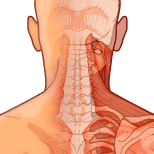Neck Pain & Injury Treatment


Neck pain is very common and can be very disabling, as well as painful. In the vast majority of neck patients at PhysioActive, the pain is caused by acute inflammation or tight muscles. Sometimes the pain is localized in the neck, but it may also refer to the thoracic spine or shoulder. If the nerve is irritated, the pain may even radiate into the arm or fingers. Common causes include poor posture, joint degeneration, muscular weakness, stress, and general inactivity

